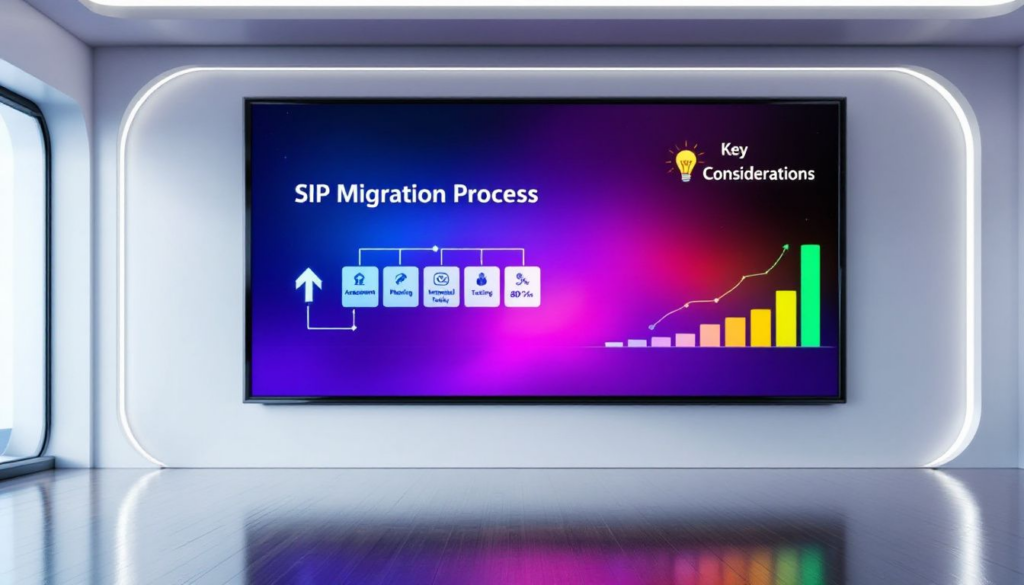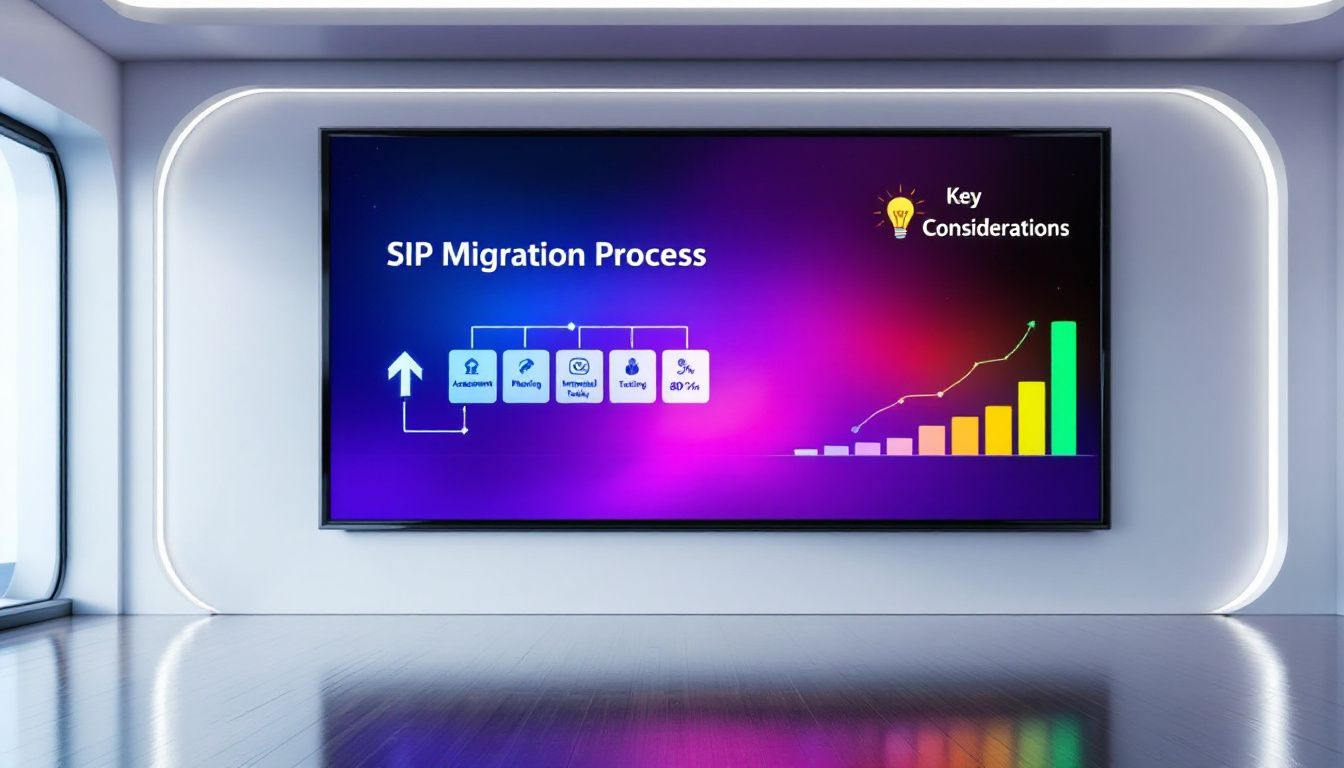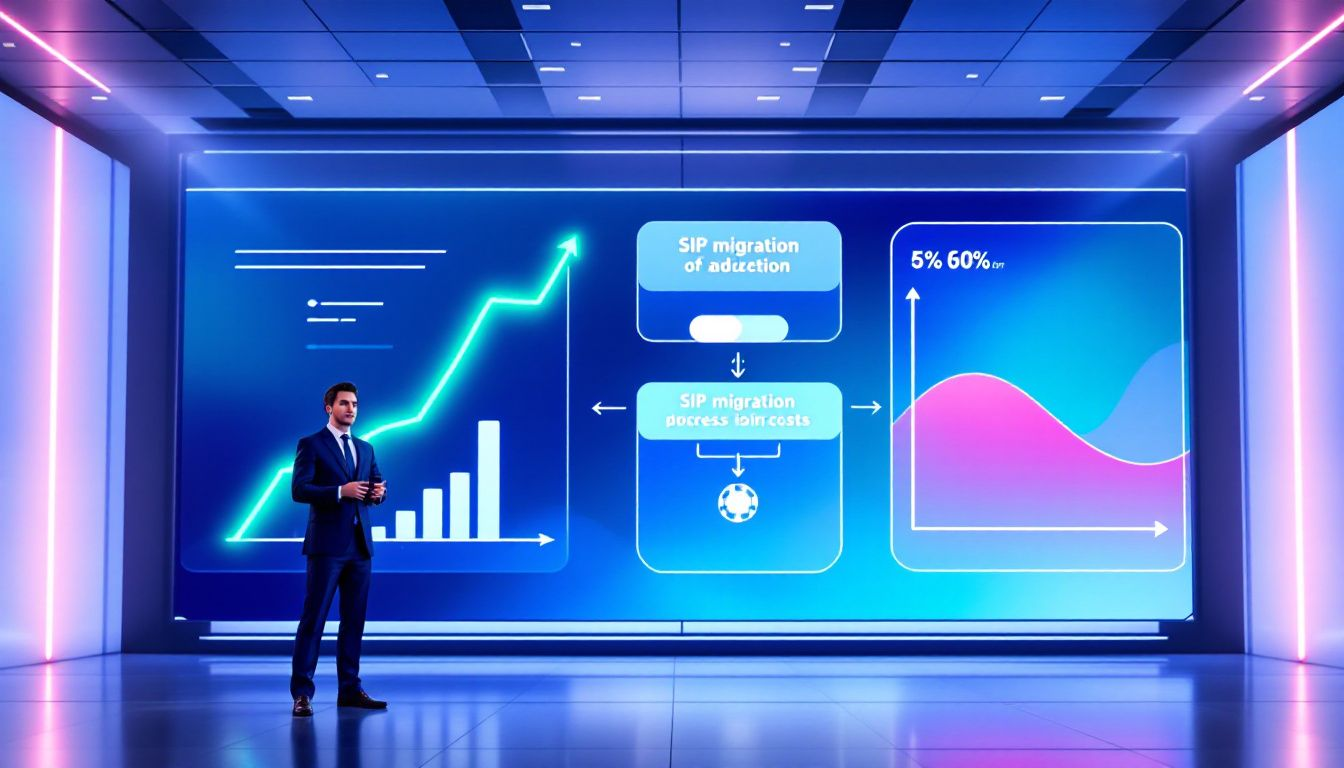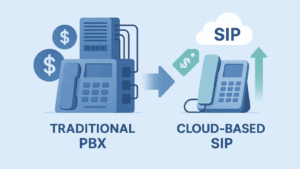
SIP Migration Checklist: Key Requirements for a Smooth Transition
Looking to upgrade your communication system? A well-crafted SIP migration strategy will guide your transition from traditional phone services to SIP trunking.
Businesses today face the challenge of staying competitive while managing costs. Switching to SIP trunking offers a modern solution by significantly reducing communication expenses and providing scalability. Unlike traditional phone lines, SIP trunking allows businesses to adjust the number of phone lines as needed, supporting growth without the burden of additional hardware.
By adopting SIP technology, businesses can modernize their communication infrastructure, preparing for future technological advancements. The potential for cost savings, improved call quality, and increased flexibility makes SIP trunking an attractive option for businesses looking to optimize their communication strategy.
Why Adopt a SIP Migration Strategy?

Adopting a SIP migration strategy significantly reduces communication costs. Switching eliminates fees tied to traditional phone services, allowing businesses to redirect funds to other critical areas.
Scalability is another compelling reason for SIP migration. SIP facilitates the growth of communication capabilities in sync with business operations, making expansion seamless. Software changes enable quick adjustments, eliminating cumbersome hardware upgrades.
SIP supports advanced features that enhance productivity and efficiency. Simplified communication management from a centralized console and flexible integration with various software applications are just a few benefits, transforming team collaboration and communication.
SIP technology modernizes your communication system, bringing it into the 21st century. Updating your strategy improves reliability and performance while preparing your business for future technological advancements.
Key Considerations for SIP Migration

Several key considerations ensure a successful SIP migration. Partnering with an experienced provider facilitates seamless implementation. Deciding between a big switch or a gradual transition and discussing upfront costs are essential steps.
The primary considerations for a successful SIP migration strategy include flexibility, cost savings, and the ability to use a wide range of devices. Conducting a thorough cost-benefit analysis before switching to SIP trunking can help address upfront costs and ongoing financial implications.
Assessing Current Infrastructure
Conducting a thorough audit of your current communication system is the first step in SIP migration. Auditing helps identify necessary upgrades for SIP compatibility, such as device types and existing phone lines. Assessing bandwidth determines if additional connections are needed to handle voice traffic.
Evaluating network capacity ensures your infrastructure can manage additional voice traffic without congestion during peak times. A network readiness test gauges your system’s readiness for SIP trunking.
Identifying the number of sites, telephony at each site, and cataloging components during the assessment is important. Evaluating call processing and routing within your current telephony setup helps identify compatibility and necessary upgrades.
Selecting the Right SIP Provider
Choosing the right SIP provider leads to a smooth and successful migration. Key criteria include service quality, reliability, interoperability, and customer support. A reliable SIP provider should have a proven track record of uptime, established redundancy measures, and robust security protocols.
Interoperability ensures seamless integration with your existing infrastructure for a smooth SIP migration strategy. Customer support is vital in guiding businesses through each step, addressing concerns and challenges.
Ultimately, selecting the right SIP provider ensures that your migration is efficient and minimizes the risk of disruptions.
Planning Your SIP Migration
A well-crafted migration plan aligns teams and minimizes business operation disturbances. Preparation and guidance from the service provider are essential for success. Good planning and support help businesses set up SIP trunking efficiently, ensuring a smooth and successful transition.
Creating a Migration Plan
A detailed plan is essential for successful SIP migration. Careful planning and proactive monitoring ensure a smooth and effective transition. A SIP migration strategy checklist helps identify potential flaws and minimize disruptions.
Testing the new SIP system before going live ensures everything works perfectly and integrates with business applications. Proper functionality through testing avoids issues once the system is operational.
Preparing for Potential Challenges
The transition from PRI to SIP involves inherent risks, but the potential rewards often justify the change. Network congestion can occur during peak usage times, and caller ID details can be misplaced during a carrier switch. Updating all network entities’ information is essential during SIP migration.
Identifying a failsafe to avoid losing voice communications and creating a centralized issue reporting system are crucial. A failsafe mechanism ensures that your business maintains seamless communication, even in the face of unexpected disruptions during the migration process.
This proactive measure is vital for maintaining uninterrupted business operations, safeguarding customer satisfaction, and protecting your brand’s reputation. By having a reliable backup system in place, you can prevent potential revenue loss and minimize the impact of any technical glitches.
On the other hand, establishing a centralized issue reporting system is equally important as it streamlines the process of identifying and addressing any problems that arise during the SIP migration.
You can create a single point of contact for all team members, ensuring that issues are reported and resolved promptly. It enhances communication within the organization, reduces downtime, and allows for swift troubleshooting, thereby ensuring minimal disruption to business operations.
By prioritizing these strategies, businesses can effectively develop SIP migration strategies and achieve a successful transition to a more modern communication infrastructure.
Executing the SIP Migration

Ensure your teams maintain effective communication within your organization during SIP migration. Setting a migration date helps teams stay focused and organized, ensuring a smooth transition.
Efficient installation and thorough testing are key to a seamless SIP migration. Engineers should identify and resolve errors during the migration process.
Installing SIP Trunks
With the right provider, installing SIP trunks can be straightforward. SIP trunking offers less bulky infrastructure and significantly reduces on-site equipment compared to ISDN. Business operations can continue without any hitches during the installation of SIP services.
Check for interoperability between SIP services and existing hosted PBX systems for successful deployment. Ensuring interoperability requires selecting the right SIP provider who understands your business communication needs and infrastructure.
An experienced provider will conduct a thorough assessment of your current systems to identify compatibility issues and recommend solutions that align with your operational requirements. They should offer comprehensive support during the integration phase, providing technical expertise to seamlessly bridge your existing technology with the new SIP services.
Additionally, the provider should have established partnerships with various technology vendors, ensuring their SIP solutions are compatible with a wide range of devices and platforms. A SIP migration strategy should minimize potential disruptions, allowing your business to fully leverage the benefits of SIP trunking.
Testing and Validation
Comprehensive testing of the SIP system ensures seamless integration with existing applications and adherence to quality standards. Rigorous testing is vital for achieving the desired quality and reliability benchmarks.
Integration testing helps pinpoint potential issues that might disrupt current systems during the SIP transition, ultimately enhancing call quality and user satisfaction.
For effective testing and validation, businesses should adopt a structured approach. Begin with a detailed plan outlining the objectives and scope of testing. Utilize both automated and manual testing methods to evaluate different aspects of the SIP system.
Engage in stress testing to simulate peak loads and identify any weaknesses in the system’s performance. It’s beneficial to involve end-users in the testing phase to gather feedback on user experience and identify any usability issues.
Additionally, create a checklist to ensure all critical functionalities are tested, and document any issues encountered along with their resolutions. Post-testing, conduct a thorough review to confirm that all components are functioning correctly and meet the defined quality standards.
Going Live and Monitoring
Going live with the new SIP system is the final step. After activation, having systems in place for ongoing monitoring helps to promptly identify and resolve potential issues.
Continuous monitoring not only ensures the reliability of your SIP system but also enhances call quality and network performance, ultimately leading to improved customer satisfaction and operational efficiency.
Optimizing Post-Migration Performance

Post-migration, continuously seeking solutions to improve employee and customer satisfaction experience is essential. Conducting regular surveys and monitoring ongoing performance ensures the SIP system meets expectations.
SIP monitoring services from a reliable provider offer real-time insights that enhance communication quality and minimize downtime. Active monitoring prevents post-migration issues and ensures a reliable SIP service communication system.
Continuous Monitoring and Optimization
Proactive monitoring prevents issues such as poor call quality and high latency. Network issues like latency and packet loss are common failures in SIP services that require ongoing monitoring to avoid disruptions. Continuous monitoring of call performance ensures reliable communication in SIP systems and helps detect and resolve issues early.
Enhancing Call Quality
Poor bandwidth can cause several problems, including poor call quality, dropped calls, and delays in SIP communications. Network congestion during peak usage times can degrade call quality.
Improving call quality involves tracking metrics such as Mean Opinion Score (MOS) and jitter regularly. Using compatible codecs prevents call disruptions after SIP. Selecting the right SIP provider helps maintain high call quality, as they offer optimized network routes and advanced technology that minimize latency and packet loss, ensuring clear and reliable voice communications.
Addressing Common Concerns
Common concerns regarding SIP migration include security, compatibility, and cost implications. SIP migration can lead to substantial cost reductions in both capital and operational expenditures.
Security Measures
Implementing strong security protocols protects SIP calls and data from potential threats, including those related to session initiation protocol. Examples of robust security measures include utilizing encryption techniques such as TLS (Transport Layer Security) and SRTP (Secure Real-time Transport Protocol) to safeguard data in transit.
Additionally, deploying a session border controller (SBC) helps manage and secure voice traffic by preventing unauthorized access and mitigating potential denial-of-service attacks.
Cost Implications
SIP trunking can save on phone bills compared to traditional systems. Setup fees for SIP trunking are generally minimal in comparison. With SIP trunking, companies benefit from lower call rates for long-distance and international calls, making it a cost-effective solution for businesses.
Improve Your Communication Strategy with SIP

SIP trunking enables voice and multimedia communication over the internet, offering a modern alternative to traditional phone lines. A key benefit is the significant cost reduction, especially for long-distance and international calls.
This technology allows businesses to easily scale their communication capabilities by adjusting the number of phone lines as needed, bringing flexibility and efficiency to operations.
Enhancing call quality is another remarkable advantage of SIP trunking. It delivers high-definition voice, improving customer interactions. SIP supports unified communication by integrating voice, video, and messaging, boosting productivity and collaboration. Centralized management simplifies monitoring and troubleshooting from a single interface.
For businesses with remote workforces, SIP trunking offers the flexibility to connect from various locations using different devices. SIP.US is an excellent partner for elevating your business communications. Their expertise in SIP technology ensures a seamless transition and ongoing support to help your business thrive. Get started with SIP.US today and transform your communication strategy.



